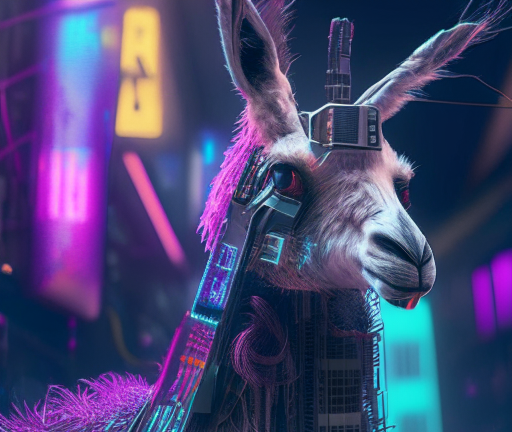minigpt-4_vicuna-13b
Maintainer: nelsonjchen

51

| Property | Value |
|---|---|
| Run this model | Run on Replicate |
| API spec | View on Replicate |
| Github link | View on Github |
| Paper link | No paper link provided |
Create account to get full access
Model overview
minigpt-4_vicuna-13b is a powerful AI model developed by nelsonjchen that combines the capabilities of MiniGPT-4 and the Vicuna-13B language model. This model is particularly adept at image question answering and image captioning, allowing users to engage with images in novel ways.
When compared to similar models like Vicuna-13B-1.1-GPTQ, vicuna-13b-GPTQ-4bit-128g, vicuna-13b-v1.3, and vicuna-7b-v1.3, minigpt-4_vicuna-13b stands out with its unique capabilities in image-related tasks.
Model inputs and outputs
minigpt-4_vicuna-13b takes in an image and a message, and generates a response that addresses the message in the context of the image. The model supports various input parameters, including the number of beams to use in the beam search and the temperature of the output.
Inputs
- Image: The input image to discuss
- Message: The message to send to the bot
- Num Beams: The number of beams to use in the beam search (between 1 and 10)
- Temperature: The temperature of the output (between 0.1 and 2)
Outputs
- Output: A response that addresses the message in the context of the input image
Capabilities
minigpt-4_vicuna-13b demonstrates impressive capabilities in image-related tasks, such as providing detailed captions for images and answering questions about the content of images. The model leverages its understanding of both visual and linguistic information to deliver insightful and contextual responses.
What can I use it for?
With its strong image understanding and generation abilities, minigpt-4_vicuna-13b can be a valuable tool for a variety of applications, including:
- Visual content generation: Use the model to generate captions, descriptions, or narratives for images, enhancing the accessibility and understanding of visual content.
- Image-based question answering: Leverage the model's capabilities to build applications that allow users to ask questions about images and receive informative responses.
- Multimodal user experiences: Integrate
minigpt-4_vicuna-13binto your products or services to enable more natural and engaging interactions between users and visual content.
Things to try
One interesting aspect of minigpt-4_vicuna-13b is its ability to generate diverse and creative responses, even when provided with relatively simple prompts. Try experimenting with different message inputs and observe how the model's outputs adapt to the context of the image, showcasing its versatility and potential for novel applications.
This summary was produced with help from an AI and may contain inaccuracies - check out the links to read the original source documents!
Related Models

minigpt-4_vicuna-7b

9
The minigpt-4_vicuna-7b model is a version of the MiniGPT-4 model that uses the Vicuna-7B language model. This model is designed for image question-answering and image captioning tasks. Compared to similar models like minigpt-4_vicuna-13b, vicuna-7b-v1.3, vicuna-13b-GPTQ-4bit-128g, Vicuna-13B-1.1-GPTQ, and vicuna-13b-v1.3, the minigpt-4_vicuna-7b model has a smaller language model size (7B parameters) but may be more efficient for certain applications. Model inputs and outputs The minigpt-4_vicuna-7b model takes two main inputs: an image and a message. The image can be provided as a URL, and the message is a prompt for the model to discuss the image. The model then generates a textual output that responds to the message and describes the image. Inputs Image**: An image URL for the model to analyze. Message**: A message or prompt for the model to respond to regarding the image. Num Beams**: The number of beams to use in the beam search algorithm, which affects the randomness and quality of the generated output. Temperature**: A value that adjusts the randomness of the output, with higher values resulting in more diverse and creative responses. Max New Tokens**: The maximum number of new tokens the model can generate in its response. Outputs Output**: The model's textual response to the input message and image. Capabilities The minigpt-4_vicuna-7b model is capable of generating detailed and coherent descriptions of images based on the provided prompt. It can also answer questions about the contents of the image and provide relevant information. The model's performance on these tasks is generally on par with or exceeds that of similar models in the minigpt-4 and vicuna families. What can I use it for? The minigpt-4_vicuna-7b model can be useful for a variety of applications, such as: Automated image captioning and description generation for marketing, e-commerce, or social media platforms. Visual question-answering systems that allow users to ask questions about images and receive relevant responses. Assistive technologies for the visually impaired, providing detailed image descriptions. Educational and research applications that involve image analysis and understanding. You can explore the capabilities of this model by trying different prompts and images, as well as comparing its performance to similar models in the minigpt-4 and vicuna families. Things to try One interesting aspect of the minigpt-4_vicuna-7b model is its ability to generate diverse and creative responses based on the input prompt and image. Try providing the model with ambiguous or open-ended prompts and see how it interprets and describes the image. You can also experiment with different temperature and beam search settings to observe how they affect the model's output.
Updated Invalid Date

vicuna-13b-v1.3

35
The vicuna-13b-v1.3 is a language model developed by the lmsys team. It is based on the Llama model from Meta, with additional training to instill more capable and ethical conversational abilities. The vicuna-13b-v1.3 model is similar to other Vicuna-based models and the Llama 2 Chat models in that they all leverage the strong language understanding and generation capabilities of Llama while fine-tuning for more natural, engaging, and trustworthy conversation. Model inputs and outputs The vicuna-13b-v1.3 model takes a single input - a text prompt - and generates a text response. The prompt can be any natural language instruction or query, and the model will attempt to provide a relevant and coherent answer. The output is an open-ended text response, which can range from a short phrase to multiple paragraphs depending on the complexity of the input. Inputs Prompt**: The natural language instruction or query to be processed by the model Outputs Response**: The model's generated text response to the input prompt Capabilities The vicuna-13b-v1.3 model is capable of engaging in open-ended dialogue, answering questions, providing explanations, and generating creative content across a wide range of topics. It has been trained to be helpful, honest, and harmless, making it suitable for various applications such as customer service, education, research assistance, and creative writing. What can I use it for? The vicuna-13b-v1.3 model can be used for a variety of applications, including: Conversational AI**: The model can be integrated into chatbots or virtual assistants to provide natural language interaction and task completion. Content Generation**: The model can be used to generate text for articles, stories, scripts, and other creative writing projects. Question Answering**: The model can be used to answer questions on a wide range of topics, making it useful for research, education, and customer support. Summarization**: The model can be used to summarize long-form text, making it useful for quickly digesting and understanding complex information. Things to try Some interesting things to try with the vicuna-13b-v1.3 model include: Engaging the model in open-ended dialogue to see the depth and nuance of its conversational abilities. Providing the model with creative writing prompts and observing the unique and imaginative responses it generates. Asking the model to explain complex topics, such as scientific or historical concepts, and evaluating the clarity and accuracy of its explanations. Pushing the model's boundaries by asking it to tackle ethical dilemmas or hypothetical scenarios, and observing its responses.
Updated Invalid Date

vicuna-7b-v1.3

28
The vicuna-7b-v1.3 is a large language model developed by LMSYS through fine-tuning the LLaMA model on user-shared conversations collected from ShareGPT. It is designed as a chatbot assistant, capable of engaging in natural language conversations. This model is related to other Vicuna and LLaMA-based models such as vicuna-13b-v1.3, upstage-llama-2-70b-instruct-v2, llava-v1.6-vicuna-7b, and llama-2-7b-chat. Model inputs and outputs The vicuna-7b-v1.3 model takes a text prompt as input and generates relevant text as output. The prompt can be an instruction, a question, or any other natural language input. The model's outputs are continuations of the input text, generated based on the model's understanding of the context. Inputs Prompt**: The text prompt that the model uses to generate a response. Temperature**: A parameter that controls the model's creativity and diversity of outputs. Lower temperatures result in more conservative and focused outputs, while higher temperatures lead to more exploratory and varied responses. Max new tokens**: The maximum number of new tokens the model will generate in response to the input prompt. Outputs Generated text**: The model's response to the input prompt, which can be of variable length depending on the prompt and parameters. Capabilities The vicuna-7b-v1.3 model is capable of engaging in open-ended conversations, answering questions, providing explanations, and generating creative text across a wide range of topics. It can be used for tasks such as language modeling, text generation, and chatbot development. What can I use it for? The primary use of the vicuna-7b-v1.3 model is for research on large language models and chatbots. Researchers and hobbyists in natural language processing, machine learning, and artificial intelligence can use this model to explore various applications, such as conversational AI, task-oriented dialogue systems, and language generation. Things to try With the vicuna-7b-v1.3 model, you can experiment with different prompts to see how the model responds. Try asking it questions, providing it with instructions, or giving it open-ended prompts to see the range of its capabilities. You can also adjust the temperature and max new tokens parameters to observe how they affect the model's output.
Updated Invalid Date

vicuna-13b

251
vicuna-13b is an open-source large language model (LLM) developed by Replicate. It is based on Meta's LLaMA model and has been fine-tuned on user-shared conversations from ShareGPT. According to the provided information, vicuna-13b outperforms comparable models like Stanford Alpaca, and reaches 90% of the quality of OpenAI's ChatGPT and Google Bard. Model inputs and outputs vicuna-13b is a text-based LLM that can be used to generate human-like responses to prompts. The model takes in a text prompt as input and produces a sequence of text as output. Inputs Prompt**: The text prompt that the model will use to generate a response. Seed**: A seed for the random number generator, used for reproducibility. Debug**: A boolean flag to enable debugging output. Top P**: The percentage of most likely tokens to sample from when decoding text. Temperature**: A parameter that adjusts the randomness of the model's outputs. Repetition Penalty**: A penalty applied to repeated words in the generated text. Max Length**: The maximum number of tokens to generate in the output. Outputs Output**: An array of strings representing the generated text. Capabilities vicuna-13b is capable of generating human-like responses to a wide variety of prompts, from open-ended conversations to task-oriented instructions. The model has shown strong performance in evaluations compared to other LLMs, suggesting it can be a powerful tool for applications like chatbots, content generation, and more. What can I use it for? vicuna-13b can be used for a variety of applications, such as: Developing conversational AI assistants or chatbots Generating text content like articles, stories, or product descriptions Providing task-oriented assistance, such as answering questions or providing instructions Exploring the capabilities of large language models and their potential use cases Things to try One interesting aspect of vicuna-13b is its ability to generate responses that capture the nuances and patterns of human conversation, as it was trained on real user interactions. You could try prompting the model with more open-ended or conversational prompts to see how it responds, or experiment with different parameter settings to explore the model's capabilities.
Updated Invalid Date